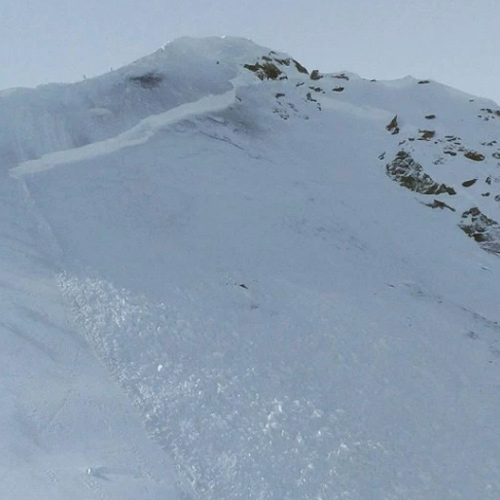High avy danger in the hills? When the forecast blinks red, skiers and riders often flock to ski resorts where ski patrollers mitigate avalanche-related hazards. But even when you aren’t earning your turns, it’s important to keep safety in mind, which may mean bringing your backcountry knowledge and equipment along with you on a lift-serve day.
In January alone, Crested Butte has received over 100 inches of snow, and the avalanche danger was rated high for seven days and hit extreme for a day. The backcountry was definitely off limits. Given those conditions, when I hit the slopes of Crested Butte Mountain Resort, I still strapped on my beacon and brought my pack and avy kit along for the ride.

An in-bounds, explosive triggered deep slab avalanche at Crested Butte Mountain Resort on January 14, 2017. [Photo] Courtesy Crested Butte Avalanche Center
Ski Patrol Control
Ski Patrollers work hard to ensure the safety of skiers at resorts, and in one day alone in this heavy snowfall period, the Crested Butte Professional Ski Patrol threw around 140 explosives to secure the famed extreme terrain from avalanches. In many cases, this work didn’t even go toward opening steep terrain. It was done to secure the areas that could impact ski runs and lifts.
One thing we know for sure about avalanches: you never know for sure. Rapidly adding 10 inches of water weight to a typical Colorado/continental snowpack is never a good thing, and when we see unusual weather events that bring heavy snowfall, we expect unusual avalanche activity to follow. Riding inbounds still comes with avalanche risk, even if explosives have reduced that risk.
Prepping for Lift-serve
Several years ago, Crested Butte Mountain Resort instituted a “beacon line” for new terrain openings. Anyone wearing an avalanche transceiver got to load the lift before people without one. The idea is that even though the CBPSP is exceptionally thorough in their mitigation work, something could slip through the cracks. And if some of the first people through the line trigger a slide, well, at least they would be wearing a beacon.
So if there is still a (small) chance of triggering an avalanche inbounds at the ski area, why are we wearing beacons but not carrying shovels or probes or airbag packs? Are we just using beacons as a tool to get on the lift sooner? According to the Colorado Avalanche Information Center, the U.S. has seen 44 avalanche deaths within ski area boundaries since 1950 (with an additional 26 ski patrollers being killed). Yes, that’s still less than one death per year, but ask yourself: would you want to be riding with your buddy when he gets buried, and you only have a beacon? No. You need your full avy kit to perform a proper avalanche rescue in time to save lives.
Bottom Line
I’m not saying that every day I’m out carving the corduroy I’m wearing my full avy kit, but with more ski areas opening up side country, the pressure to open steep terrain as soon as possible during and after storms and with increasing crowds, it is worth considering whether or not you should bring your kit to the resort. This decision could save lives.
—
Steve Banks is an IFMGA/AMGA mountain guide based in Crested Butte, Colo. where he is the Director of Mountain Guide Operations at Irwin Guides. He has been a professional ski patroller and a forecaster and director of the Crested Butte Avalanche Center and is currently an Instructor Team member for the AMGA.











Backpacks and ski lifts aren’t exactly compatible. How do you schlepp your shovel and probe along? I guess you can rotate the backpack to your chest for the ride up?
If you’re backpack is big, then yes, swinging it around to sit on your lap for the ride is how most people do it. Otherwise, if all you’re carrying is the bare minimum in-bounds, you can get super small packs that just make it a little more awkward, but you usually don’t have to take them all the way off. For example, I have an old Dakine Heli pack for my in-bounds days that is tiny, and barely gets in the way on the lift.